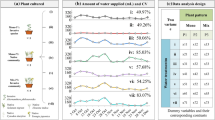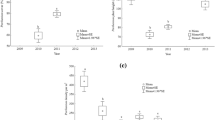Abstract
Hyptis suaveolens is considered one of the most potent invaders in the eastern part of Uttar Pradesh, India. Climate change especially precipitation variability along with invasion has enormous consequences. To understand how an invasive plant (H. suaveolens) performs and interacts with precipitation variability, particularly in tropical monsoon climate, is vital. To assess the above, three rainout shelters with simulated rainfall of 1600 mm (60% more rainfall than ambient), 1100 mm (average rainfall) and 800 mm (20% less rainfall than ambient) along with one unsheltered plot (open C) were established. Three invaded grassland (IG) and three uninvaded grasslands (NIG) patches of 1 × 1 m2 size were established randomly in each sheltered and unsheltered plot. Among the studied physiological properties and growth measurements, photosynthetic rate, height, diameter and biomass varied significantly with precipitation, in general, the maximum value of these in plots receiving maximum precipitation. Also, the aboveground biomass of H. suaveolens was found to be more sensitive towards precipitation treatment than belowground biomass. H. suaveolens biomass was linearly related to soil moisture (R2 = 0.73), and a linear combination of SM and soil pH increased the R2 value by 19%. The results indicate that H. suaveolens mediates certain soil properties especially related to N-mineralisation, to maintain a constant supply of nutrient, for faster growth under the favourable condition of enhanced precipitation. These findings suggest that the population of H. suaveolens has not evolved drought tolerance, so it is likely that H. suaveolens will not spread in the part of the world which is drier either naturally or due to climate change.




Similar content being viewed by others
References
Ackerly, D. D., Dudley, S. A., Sultan, S. E., Schmitt, J., Coleman, J. S., Linder, C. R., et al. (2000). The evolution of plant ecophysiological traits: Recent advances and future directions: New research addresses natural selection, genetic constraints, and the adaptive evolution of plant ecophysiological traits. Bioscience, 50(11), 979–995.
Afreen, T., & Singh, H. (2019). Does change in precipitation magnitude affect the soil respiration response? A study on constructed invaded and uninvaded tropical grassland ecosystem. Ecological Indicators, 102, 84–94.
Afreen, T., Srivastava, P., Singh, H., & Singh, J. S. (2018). Effect of invasion by Hyptis suaveolens on plant diversity and selected soil properties of a constructed tropical grassland. Journal of Plant Ecology, 11(5), 751–760.
Allen, K., Dupuy, J. M., Gei, M. G., Hulshof, C., Medvigy, D., Pizano, C., et al. (2017). Will seasonally dry tropical forests be sensitive or resistant to future changes in rainfall regimes? Environmental Research Letters, 12(2), 023001.
Allison, S. D., & Vitousek, P. M. (2004). Rapid nutrient cycling in leaf litter from invasive plants in Hawai’i. Oecologia, 141(4), 612–619.
American Public Health Association, APHA. (1985). Standard methods for the examination of water and wastewater. American Public Health Association, American Water Works association, Water Environment Federation, Washington.
Brookes, P. C., Landman, A., Pruden, G., & Jenkinson, D. S. (1985). Chloroform fumigation and the release of soil nitrogen: A rapid direct extraction method to measure microbial biomass nitrogen in soil. Soil Biology and Biochemistry, 17(6), 837–842.
Campo, J. (2016). Shift from ecosystem P to N limitation at precipitation gradient in tropical dry forests at Yucatan, Mexico. Environmental Research Letters, 11(9), 095006.
Cavaleri, M. A., & Sack, L. (2010). Comparative water use of native and invasive plants at multiple scales: A global meta-analysis. Ecology, 91(9), 2705–2715.
Chadwick, R., Good, P., Martin, G., & Rowell, D. P. (2016). Large rainfall changes consistently projected over substantial areas of tropical land. Nature Climate Change, 6(2), 177–181.
Cornelissen, J. H. C., Lavorel, S., Garnier, E., Diaz, S., Buchmann, N., Gurvich, D. E., Reich, P. B., Ter Steege, H., Morgan, H. D., Van Der Heijden, M. G. A., & Pausas, J. G. (2003). A handbook of protocols for standardised and easy measurement of plant functional traits worldwide. Australian Journal of Botany, 51(4), 335–380.
Crawley, M. J. (1986). The population biology of invaders. Phil. Trans. R. Soc. Lond. B, 314(1167), 711–731.
Daehler, C. C. (2003). Performance comparisons of co-occurring native and alien invasive plants: Implications for conservation and restoration. Annual Review of Ecology, Evolution, and Systematics, 34(1), 183–211.
Diez, J. M., D’Antonio, C. M., Dukes, J. S., Grosholz, E. D., Olden, J. D., Sorte, C. J., Blumenthal, D. M., Bradley, B. A., Early, R., Ibáñez, I., & Jones, S. J. (2012). Will extreme climatic events facilitate biological invasions? Frontiers in Ecology and the Environment, 10(5), 249–257.
Ehrenfeld, J. G. (2003). Effects of exotic plant invasions on soil nutrient cycling processes. Ecosystems, 6(6), 503–523.
Eno, C. F. (1960). Nitrate production in the field by incubating the soil in polyethylene bags 1. Soil Science Society of America Journal, 24(4), 277–279.
Fernández, R. J., Wang, M., & Reynolds, J. F. (2002). Do morphological changes mediate plant responses to water stress? A steady-state experiment with two C4 grasses. New Phytologist, 155(1), 79–88.
Gill, R.A., O’Connor, R.C., Rhodes, A., Bishop, T.B., Laughlin, D.C. and Clair, S.B.S., 2018. Niche opportunities for invasive annual plants in dryland ecosystems are controlled by disturbance, trophic interactions, and rainfall. Oecologia, pp.1-11.
Greve, P., Orlowsky, B., Mueller, B., Sheffield, J., Reichstein, M., & Seneviratne, S. I. (2014). Global assessment of trends in wetting and drying over land. Nature Geoscience, 7(10), 716–721.
Grimm, N. B., Chapin, F. S., Bierwagen, B., Gonzalez, P., Groffman, P. M., Luo, Y., Melton, F., Nadelhoffer, K., Pairis, A., Raymond, P. A., & Schimel, J. (2013). The impacts of climate change on ecosystem structure and function. Frontiers in Ecology and the Environment, 11(9), 474–482.
Hannah, L., Midgley, G. F., & Millar, D. (2002). Climate change-integrated conservation strategies. Global Ecology and Biogeography, 11(6), 485–495.
Jackson, M.L., 1958. Soil chemical analysis. Prentice-Hall, Inc. Englewood Cliffs, NJ p, 45, p.46.
Kane, J. M., Meinhardt, K. A., Chang, T., Cardall, B. L., Michalet, R., & Whitham, T. G. (2011). Drought-induced mortality of a foundation species (Juniperus monosperma) promotes positive afterlife effects in understory vegetation. Plant Ecology, 212(5), 733–741.
Kim, D. H., Doyle, M. R., Sung, S., & Amasino, R. M. (2009). Vernalization: Winter and the timing of flowering in plants. Annual Review of Cell and Developmental, 25, 277–299.
Kriticos, D. J., Yonow, T., & McFadyen, R. E. (2005). The potential distribution of Chromolaena odorata (Siam weed) in relation to climate. Weed Research, 45(4), 246–254.
Neena, P., & Joshi, P. K. (2013). Effects of climate change on invasion potential distribution of Lantana camara. Journal of Earth Science & Climatic Change, 4(6).
Nelson, D.W. and Sommers, L., 1982. Total carbon, organic carbon, and organic matter 1. Methods of soil analysis. Part 2. Chemical and microbiological properties, (methodsofsoilan2), pp.539-579.
Obrist, D., DeLucia, E. H., Arnone, I. I. I., & J.A. (2003). Consequences of wildfire on ecosystem CO2 and water vapour fluxes in the Great Basin. Global Change Biology, 9(4), 563–574.
Padalia, H., Srivastava, V., & Kushwaha, S. P. S. (2014). Modeling potential invasion range of alien invasive species, Hyptis suaveolens (L.) Poit. in India: Comparison of MaxEnt and GARP. Ecological informatics, 22, 36–43.
Padalia, H., Srivastava, V., & Kushwaha, S. P. S. (2015). How climate change might influence the potential distribution of weed, bushmint (Hyptis suaveolens)? Environmental Monitoring and Assessment, 187(4), 210.
Paez-Garcia, A., Motes, C., Scheible, W. R., Chen, R., Blancaflor, E., & Monteros, M. (2015). Root traits and phenotyping strategies for plant improvement. Plants, 4(2), 334–355.
Peterson, A. T. (2003). Predicting the geography of species’ invasions via ecological niche modeling. The Quarterly Review of Biology, 78(4), 419–433.
Piper, C.S., 1944. Dry ashing. Soil and Plant Analysis. Interscience, Publishers Inc., New York, pp.221-222.
Prater, M. R., Obrist, D., Arnone, J. A., & DeLucia, E. H. (2006). Net carbon exchange and evapotranspiration in postfire and intact sagebrush communities in the Great Basin. Oecologia, 146(4), 595–607.
Raizada, P. (2006). Ecological and vegetative characteristics of a potent invader, Hyptis suaveolens Poit. from India. Lyonia, 11(2), 115–120.
Raizada, P., Singh, A., & Raghubanshi, A. S. (2009). Comparative response of seedlings of selected native dry tropical and alien invasive species to CO2 enrichment. Journal of Plant Ecology, 2(2), 69–75.
Rathore, L. S., Attri, S. D., & Jaswal, A. K. (2013). State level climate change trends in India. Meteorological Monograph No. ESSO/IMD/EMRC/02/2013, Government of India Ministry of Earth Sciences, Earth System Science Organisation, India Meteorological Department, p 156.
Rolli, E., Marasco, R., Vigani, G., Ettoumi, B., Mapelli, F., Deangelis, M. L., Gandolfi, C., Casati, E., Previtali, F., Gerbino, R., & Pierotti Cei, F. (2015). Improved plant resistance to drought is promoted by the root-associated microbiome as a water stress-dependent trait. Environmental Microbiology, 17(2), 316–331.
Sharma, G. P., & Raghubanshi, A. S. (2007). Effect of Lantana camara L. cover on local depletion of tree population in the Vindhyan tropical dry deciduous forest of India. Applied Ecology and Environmental Research, 5, 109–121.
Sharma, G. P., Singh, J. S., & Raghubanshi, A. S. (2005). Plant invasions: Emerging trends and future implications. Current Science, 88(5), 726–734.
Singh, V., & Singh, H. (2012). Leaf construction cost and related ecophysiological parameters of rice crop and its important weeds. Rice Science, 19(3), 233–240.
Singh, V., Gupta, S., Singh, H., & Raghubanshi, A. S. (2015). Ecophysiological characteristics of five weeds and a wheat crop in the Indo-Gangetic Plains, India. Weed biology and management, 15(3), 102–112.
Singh, V., Singh, H., Sharma, G. P., & Raghubanshi, A. S. (2011). Eco-physiological performance of two invasive weed congeners (Ageratum conyzoides L. and Ageratum houstonianum Mill.) in the Indo-Gangetic plains of India. Environmental Monitoring and Assessment, 178(1–4), 415–422.
Strickland, M. S., Devore, J. L., Maerz, J. C., & Bradford, M. A. (2010). Grass invasion of a hardwood forest is associated with declines in belowground carbon pools. Global Change Biology, 16(4), 1338–1350.
te Beest, M., Elschot, K., Olff, H., & Etienne, R. S. (2013). Invasion success in a marginal habitat: An experimental test of competitive ability and drought tolerance in Chromolaena odorata. PLoS One, 8(8), e68274.
Thapa, S., Chitale, V., Rijal, S. J., Bisht, N., & Shrestha, B. B. (2018). Understanding the dynamics in distribution of invasive alien plant species under predicted climate change in Western Himalaya. PloS one, 13(4), e0195752.
Vance, E. D., Brookes, P. C., & Jenkinson, D. S. (1987). An extraction method for measuring soil microbial biomass C. Soil Biology and Biochemistry, 19(6), 703–707.
Vitousek, P.M., Loope, L.L. and Westbrooks, R., 2017. Biological invasions as global environmental change.
Wang, X., Liu, L., Liu, S., Sun, X., Deng, Z., Pi, Y., Sun, X., & Tang, K. (2004). Isolation and molecular characterization of a new CRT binding factor gene from Capsella bursa-pastoris. BMB Reports, 37(5), 538–545.
Xu, Y. (2016). Envirotyping for deciphering environmental impacts on crop plants. Theoretical and Applied Genetics, 129(4), 653–673.
Zouaoui, R., Ksontini, M., Ourry, A., & Ferchichi, A. (2013). Effect of drought on leaf gas exchange, water-use efficiency and carbon isotope discrimination in two species (Rhus tripartitum (Ucria) Grande and Ziziphus lotus (L.)) in arid zone of Tunisia threatened of disappearance. International Journal of Agronomy and Plant Production, 4(7), 1616–1627.
Acknowledgments
TA is thankful to the University Grant Commission (UGC, New Delhi) for providing Maulana Azad National Fellowship. We also acknowledge the coordinator, CAS, Department of Botany, Banaras Hindu University, for providing research facilities to carry out this research. Authors are also thankful to the two anonymous reviewers’ suggestions for the betterment of the MS.
Author information
Authors and Affiliations
Contributions
TA conceived the experiment and wrote the manuscript. VS, VKY and RPS help in experimental analysis and field maintenance. HS contributes to manuscript writing and has corrected the manuscript. All authors have reviewed the manuscript.
Corresponding author
Ethics declarations
Conflict of interest
The authors declare that they have no conflict of interest.
Additional information
Publisher’s note
Springer Nature remains neutral with regard to jurisdictional claims in published maps and institutional affiliations.
Electronic supplementary material
ESM 1
(DOCX 18 kb)
Rights and permissions
About this article
Cite this article
Afreen, T., Singh, V., Yadav, V.K. et al. Impact of rainfall variability on the ecophysiology of Hyptis suaveolens: a study in the constructed tropical grassland. Environ Monit Assess 192, 388 (2020). https://doi.org/10.1007/s10661-020-08340-z
Received:
Accepted:
Published:
DOI: https://doi.org/10.1007/s10661-020-08340-z




